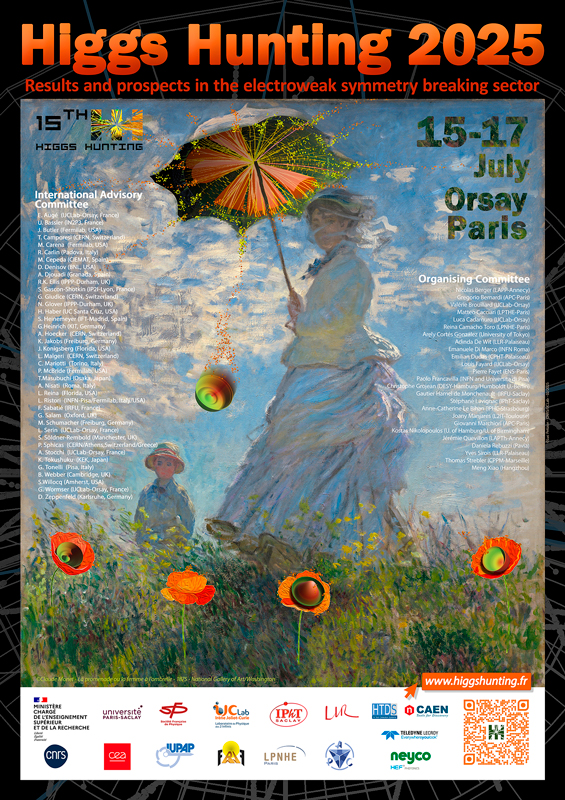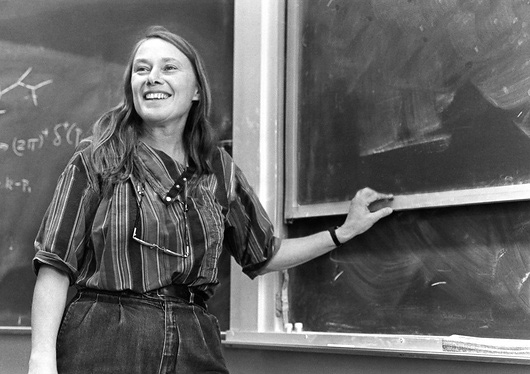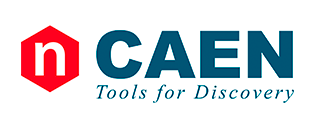- Indico style
- Indico style - inline minutes
- Indico style - numbered
- Indico style - numbered + minutes
- Indico Weeks View
Higgs Hunting 2025
→
Europe/Paris
100/-1-A900 - Auditorium Joliot Curie (IJCLab)
100/-1-A900 - Auditorium Joliot Curie
IJCLab
IJCLab Orsay (Tuesday) & APC Paris (Wednesday & Thursday)
140
Montrer la salle sur la carte
Description
 The origin of Electroweak symmetry breaking is one of the central topics of research in fundamental physics. The discovery of a Higgs boson at CERN on July 4th, 2012, following a hunt that spanned several decades and multiple colliders, changed the landscape of these investigations and provided key evidence for the Brout-Englert-Higgs mechanism of mass generation through the spontaneous breaking of Electroweak symmetry.
The origin of Electroweak symmetry breaking is one of the central topics of research in fundamental physics. The discovery of a Higgs boson at CERN on July 4th, 2012, following a hunt that spanned several decades and multiple colliders, changed the landscape of these investigations and provided key evidence for the Brout-Englert-Higgs mechanism of mass generation through the spontaneous breaking of Electroweak symmetry.
More than ten years later, the hunt goes on several fronts, in particular for:
- New physics through precision studies of the properties of the Higgs boson : in particular its mass, spin and couplings to other Standard Model particles.
- New production and decay modes, in particular in processes involving multiple Higgs bosons which provide key insight into the shape of the Higgs potential.
- New Higgs-like states and signals for physics beyond the Standard Model.
The 15th workshop of the « Higgs Hunting » series organized on July 15-17 2025 will present an overview of these topics, focusing in particular on new developments in the LHC Run-2 analyses, detailed studies of Higgs boson properties and possible deviations from Standard Model predictions. Highlights will also include a first look at LHC Run-3 analyses, prospects from studies at future colliders, and recent theoretical developments.
The workshop will be held in person in Orsay, for the first day, and Paris, for the two following days, to continue the Higgs Hunting tradition of lively discussions during and after the sessions. Remote participation will also be made possible for those unable to attend in person. No registration fees are asked for remote participation.
|
 Mary K. Gaillard passed away on 23 May 2025. A major figure in particle theory, she made fundamental contributions to the establishment of the Standard Model. Notably, she achieved a successful determination of the charm quark mass from kaon decays; predicted three-jet events in e+ e- collisions, providing crucial evidence for the existence of gluons; and forecasted the bottom quark mass within the framework of unified theories. She also pioneered systematic studies of Higgs boson production and decay at particle colliders, sketching its first phenomenological profile that launched its experimental hunt. Beyond the Standard Model, Mary K. made numerous and invaluable contributions to Grand Unified Theories and supersymmetric theories, including work on proton decay, supersymmetry breaking, and effective supergravity theories derived from superstrings. The Higgs Hunting workshop was honored to welcome her in 2016 as the speaker for its traditional historical talk Mary K. Gaillard passed away on 23 May 2025. A major figure in particle theory, she made fundamental contributions to the establishment of the Standard Model. Notably, she achieved a successful determination of the charm quark mass from kaon decays; predicted three-jet events in e+ e- collisions, providing crucial evidence for the existence of gluons; and forecasted the bottom quark mass within the framework of unified theories. She also pioneered systematic studies of Higgs boson production and decay at particle colliders, sketching its first phenomenological profile that launched its experimental hunt. Beyond the Standard Model, Mary K. made numerous and invaluable contributions to Grand Unified Theories and supersymmetric theories, including work on proton decay, supersymmetry breaking, and effective supergravity theories derived from superstrings. The Higgs Hunting workshop was honored to welcome her in 2016 as the speaker for its traditional historical talkthan you can see in
Mary K. spent a substantial portion of her career in France and at CERN, from her doctoral studies in Orsay to the creation of the theoretical physics laboratory LAPTh in Annecy. The Higgs Hunting workshop extends its deepest condolences to her colleagues at the University of California, Berkeley, and to her family. |

 |
 |
 |
|
Valérie Brouillard et Emilie Bonnardel
Participants
Alejandro Gutierrez-Rodriguez
alexis Maloizel
Alfredo Urbano
Aman Desai
Amrutha Krishna
Andrea Sciandra
Andrew Akeroyd
Angela Zaza
Anne-Catherine Le Bihan
Antoine Long
Arthur Schaffer
Ashok Kumar Aryal
Avinanda Chaudhuri
Ben Kilminster
Benedetta Camaiani
Benjamin Fuks
Benjamin Massoteau
BERCY LOLA Lola
Brahim ELOUADI
Brando Bellazzini
Carlo Oleari
Chayanit Asawatangtrakuldee
Christian Verollet
Christophe Ochando
Christophe ROLAND
Claude Charlot
Cyril Hugonie
Deepanshi Singh
Elena Mazzeo
Eleni Skorda
Elise Le Boulicaut Ennis
Fabio Lucio Alves
Fabrice Couderc
Fairouz Ben Salah
Federica De Riggi
Federico Buccioni
Federico Ferri
Florencia Canelli
Florian Beaudette
Florian NORTIER
Francesco Orlandi
Francois Richard
Francois Vannucci
Frank Zimmermann
Gadi Ninio
Gamze Sokmen
Gautier Hamel de Monchenault
Gavin Salam
Giacomo Magni
Giovanni MARCHIORI
Gregorio BERNARDI
Greta Brianti
Hyejin Kwon
Ines Combes
Irena Nikolic
Jacobo Konigsberg
Jaouad El Falaki
Jean-François Grivaz
Joany Manjarres Ramos
Johann Collot
Jose Santiago
José Ocariz
Juan Rojo
Julie Malcles
Jérémie Quevillon
Karl Jakobs
Kazuki Kojima
Keisho Hidaka
Kentarou Mawatari
Kirtimaan Mohan
Kosuke Itabashi
Krittika Sarkar
Lavish Kumar
Leonidas Paizanos
Lorenzo Santi
Louis FAYARD
Lourdes Urda
Luca Cadamuro
Lucia Di Ciaccio
Lydia Iconomidou-Fayard
Léa-Maria Rabour
Marc Winter
Marco Chiusi
Maria A. Hernandez-Ruiz
Maria Cepeda
Maria Clara Alvim Sousa
Maria De Los Angeles FAUS-GOLFE
Maria Mazza
Marko Mihovilovic
Marko Pesut
Martina Manoni
Mathieu Pellen
Maxime Soncin
Mi Ran KIM
Mia West
miaoran lu
Mintu Kumar
Neha Rawal
Nicholas Wardle
Nicolas Berger
Nicolas Cartalade
Oleksii Kurdysh
Oleksii Matsedonskyi
Olivier SALIN
Pamela Ferrari
Paolo Francavilla
Patricia McBride
Paul Gaigne
Paulo Cesar Machado de Abreu Farias
Philipp Gadow
Philipp Rendler
Pierre Ramond
Ragansu Chakkappai
Reisaburo Tanaka
Ricardo Barrue
Roberto Salerno
Roman Poeschl
Ruth Amella Ranz
Sabine Starita
Samuele Ronchi
Siddhesh Sawant
Stefano Di Noi
Stefano Manzoni
Subhadip Mitra
Suman Chatterjee
Surya Sundar Raman
Suzanne GASCON-SHOTKIN
Sven Heinemeyer
Swagata Ghosh
Tania Robens
Tanwir Alam
Tao Hsu
Thomas Gehrmann
Thomas Saltel
Théo Cuisset
Tom Fournier
Ulrich GOERLACH
Victor Enguita
Vincent BOUDRY
Vladimir Gligorov
Vladimir Pastushenko
Walaa Elmetenawee
Wanda ISNARD
Yangfan Zhang
Yara Coutinho
Yves Sirois
Zirui Liu
Ziyu Dong
ID de réunion Zoom
97546963685
Hôte
Louis FAYARD
Hôte alternatif
Nicolas Berger
URL Zoom

